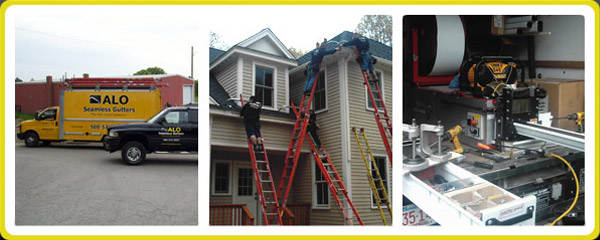Now that I have figured out how to post video clips, it’s almost past time to talk about reverse flashing. But I have to keep my boss happy (doesn’t everyone?), and I’ve been promising this for a while now, so we’re going to now investigate the option of reverse flashing.
First I just want to say a quick hello to our owner/operator Joe Alo and crew. They’ve been very busy with all the work I’ve been booking, and what a great job they’re doing! We recently finished installing new seamless gutters in Acton and Concord that came out wonderful – one had removal of an old system, and the homeowner commented that the difference is night and day. Joe and the boys have recently spent 2 full days in Leominster as well, working for one of our long-time customers at a large condominium complex, and the amount of gutter they installed while there was phenomenal! Great job guys – you make my job so much easier. And just knowing that Joe is on site for almost all the work ensures complete functionality and customer satisfaction every time. Thank you.
So what is reverse flashing and how does it work? And why do we mention it in our cover letters and many times on-site? Well, let’s get a little background first. A typical home has a drip edge installed under the first row of shingles and down over the very top of either the fascia, or if installed, the shadowboard (sometimes referred to as a frieze board, the square type of trim at the top of the fascia). This small piece of metal is to cover the tops of the wood fascia (or shadowboard) and the resultant small gap where the fascia is mounted on the rafter tails. It is designed to keep water from wicking back into the home and causing damage, directing any drips downward and away from wood joints where gapping occurs. When we install new gutters on a home, any home, we always attempt to manipulate the drip edge out a little so that any drips will fall directly into the gutter. If we left it flat against the fascia or shadowboard, any drips would follow the wood down and get behind the gutters – eventually rotting any wood, staining both wood and PVC composite board, and sometimes even dripping on entryways and stairs. This is due to wicking action – when the rain slows down and the roof is just dripping, the slower moving droplets will follow the contours down from the shingle edge, actually run back up under the shingle and then down the drip edge. So by pulling it out and away from the surface it’s flat against, the water cannot wick back and has nowhere to go except directly down and into the gutter. Sounds like a foolproof solution, but it’s not that easy. Some drip edge cannot be manipulated due to it’s thickness (think of old galvanized thick metal), or because it has deteriorated over time and any movement would cause complete degradation. And even when we do manipulate the drip edge to catch 99.5% of all drips, Mother Nature can be very sneaky and either push the drip edge back flush over the winter with her ice and snow, or can overcome the manipulated drip edge by blowing a hard wind against the home – driving the rain back and down between the gutter and fascia. This is where reverse flashing comes in – also referred to as drip edge extender by other companies. Here’s a picture of what aluminum reverse flashing looks like installed in a new gutter:
As you can see, it slips in under the existing drip edge, gets fastened with non-corrosive stainless steel screws, and goes directly to the inside of the seamless gutter. There is no way for any drips to occur behind the gutters. Even Mother Nature can’t push it back in the winter because it is inside the gutter, and she can’t overcome it with wind. Check out this video of aluminum reverse flashing in action:
This is why we use it and recommend it frequently. But there are other considerations as well – it is all aluminum and adds to the overall expense, and some homeowners don’t mind a few small drips here and there. As I stated earlier, normal drip edge manipulation will catch up to 99.5% of the drips, and we have many homeowners who want to see how things perform before investing any more into their gutter system. If, however, you want to totally eliminate all drips, then our reverse flashing is the solution. We guarantee its’ effectiveness. Keep in mind that any gutter system that doesn’t have reverse flashing is susceptible to the occasional drip now and then – this is not a function of the gutters, but rather the roof edge/drip edge combination. We ensure a tight fit and minimal drips by adding stainless steel tacks between the bar hangers so the gutter is flat and tight to the fascia, and by gently manipulating out the existing drip edge. But this is not always effective at total elimination of drips, and reverse flashing becomes the best solution. We’re always glad to add it to a quote as an option – just ask.
Stay tuned for more good stuff coming along. Joe and crew are doing some great specialty downspout work in the next few weeks and hopefully I’ll get some pictures to post. And remember, call us with any questions or concerns as we believe a well-educated consumer is our best ally.






Follow Us!